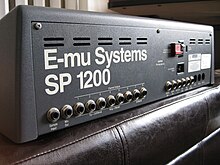E-mu SP-1200
| SP-1200 | |
|---|---|
 E-mu SP-1200 sampler | |
| Manufacturer | E-mu Systems Rossum Electro-Music (2021 reissue) |
| Dates | 1987–1990, 1993-1998,[1] 2021–present |
| Price | US $2,745[1] US $3,999 (2021 reissue) |
| Technical specifications | |
| Polyphony | polyphonic 8 voices |
| Synthesis type | 12-bit samples, 26.04 kHz |
| Filter | SSM2044,[1] SSI2144 (2021 reissue)[2] |
| Storage memory | 10 seconds sample time, 100 user patterns, 100 user songs |
| Effects | Individual level and tuning for all sounds |
| Input/output | |
| Keyboard | 8 hard plastic buttons |
| External control | MIDI, SMPTE |


The E-mu SP-1200 is a sampling drum machine[3] designed by Dave Rossum released in August 1987 by E-mu Systems.[1]
Like its predecessor, SP-12, the SP-12, the SP-1200 was designed as a drum machine featuring user sampling.[4] The distinctive sound is often described as "warm" and "gritty,"[1][2] and attributed to SP-1200's low 26.04 kHz sampling rate, its 12-bit sampling resolution, and its SSM2044 filter chips,[1] has sustained demand for the SP-1200 more than thirty-five years after its debut, despite the availability of digital audio workstations and samplers/sequencers with superior technical specifications.
The SP-1200 is strongly associated with hip hop's golden age. Its ability to construct the bulk of a song within one piece of portable gear, a first for the industry,[5] reduced studio costs and increased creative control for hip-hop artists. According to the Village Voice, "The machine rose to such prominence that its strengths and weaknesses sculpted an entire era of music: the crunchy digitized drums, choppy segmented samples, and murky filtered basslines that characterize the vintage New York sound are all mechanisms of the machine."[6]
Features
The SP-1200 can store up to 100 patterns, 100 songs, and has a 5,000-note maximum memory for drum sequences. It also has a mono mix output and eight individual outputs, MIDI in/out/through, SMPTE sync, and a metronome output. Selecting between memory banks A, B, C, and D gives the user easy access to each of the 32 sounds. The front panel contains eight volume and pitch faders for each sound in the selected bank. Below each fader is a large button to initialize the sound, or select the sound for editing. The sequencer works in the familiar pattern-style of placing short consecutive sections of samples into a song. The user can easily add swing quantization and tempo changes. The sequencer can sync the tempo to SMPTE, MIDI, or analogue clock pulses and is also capable of synchronizing the tempo to a tapping finger with the tap-tempo button."[7]
SP-1200 uses a 12-bit linear data format and the same 26.04kHz sample rate E-mu previously used in Drumulator and SP-12.[8][1][9][10][11][12] The sample rate was chosen early on in Drumulator’s development as a compromise between bandwidth and sampling time.[8][1][13] A reconstruction filter was deliberately omitted, resulting in a brighter sound due to imaging (sounds above the sample rate).[10][13]
Differences from the SP-12
Unlike the SP-12, the SP-1200 does not contain ROM-based samples; all samples are stored in volatile RAM and loaded from floppy disk. The AD/DA converters remain 12 bit, as 16 bit converters were still expensive and found only on high-end gear, such as the contemporary E-Mu Emulator 3, which had a list price of over US$15,000. Maximum sampling time was doubled from the upgraded SP-12 Turbo, to 10 seconds, but the maximum single sample was 2.5 seconds. The SP-1200 retained all of the I/O capabilities from the SP-12, minus the cassette output and 1541 Commodore Computer floppy disk I/O.
Technique
The limited sampling time of the SP-1200 was overcome within the late 1980s hip hop production circles by sampling 33⅓ rpm records at 45 rpm, with an additional pitch increase, then replaying the sample from the SP-1200 at a much slower speed (by the use of Multipitch and/or tune/decay edit functions). This expanded the total sampling time while at the same time decreasing the resolution. By the early 1990s, nearly every working hip hop producer had adopted this technique as industry standard until the advent of newer samplers such as Akai's MPC60, which provided higher sampling rates and more sampling time.
Reissue
In 2021, Dave Rossum announced that he would be reissuing the SP-1200 through his company, Rossum Electro-Music.[2] The Rossum SP-1200 provides 20 seconds total sampling time, equal to twice the original SP-1200's 10 seconds.[2]
See also
References
- ^ a b c d e f g h Keeble, Rob (September 2002). "30 Years of Emu". Sound on Sound. SOS Publications Group. Retrieved 5 July 2024.
- ^ a b c d Mullen, Matt (4 November 2021). "Reissue of the classic SP-1200 sampler announced by Dave Rossum". MusicRadar. Retrieved 5 July 2024.
- ^ Vail, Mark (2014). The Synthesizer. Oxford University Press. p. 74. ISBN 978-0195394894.
- ^ Rossum, Dave. "For whom was the SP-1200 originally designed?". youtube.com. Rossum Electro-Music. Retrieved 5 July 2024.
- ^ Swash, Rosie (12 June 2011). "The SP-1200 sampler changes everything". The Guardian. Guardian News and Media Limited. Retrieved 16 July 2019.
- ^ Detrick, Ben (6 November 2007). "The Dirty Heartbeat of the Golden Age". The Village Voice. Retrieved 2020-05-29.
- ^ The Emulator Archive
- ^ a b Hyland, Simon (2011). SP-1200: The Art and Science. 27Sens. p. 60. ISBN 2953541012.
- ^ E-mu Systems Drumulator Service Manual. E-mu Systems. 1983. Retrieved 5 July 2024.
- ^ a b Davies, Steve (1985). SP-12 Sampling Percussion System Service Manual (PDF). E-mu Systems. Retrieved 5 July 2024.
- ^ SP-1200 Sampling Percussion System Service Manual. E-mu Systems. 1987. Retrieved 5 July 2024.
- ^ "SP-1200". Rossum Electro-Music. Archived from the original on 5 July 2024. Retrieved 5 July 2024.
- ^ a b Rossum, Dave. "Why do SP-1200 channel outputs feature different filters?". youtube.com. Rossum Electro-Music. Retrieved 5 July 2024.











